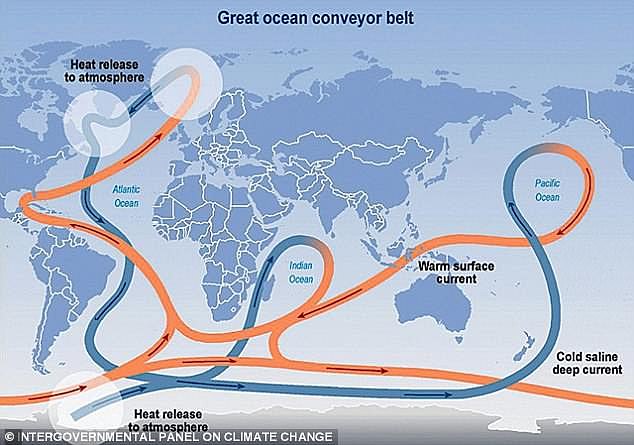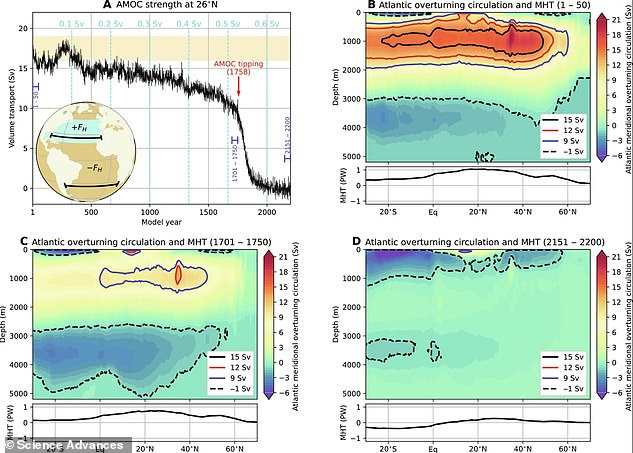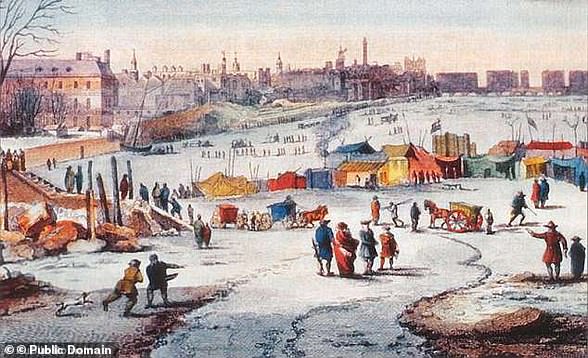The real-life Day After Tomorrow: The Gulf Stream could COLLAPSE as early as 2025 – plunging Europe into a deep freeze, scientists warn
In the 2004 film The Day After Tomorrow, humanity is plunged into a nightmarish international storm that plunges the planet into a new ice age.
And while the blockbuster was relegated to the realm of science fiction, the science behind this terrifying scenario is true.
Within a few years, melting glaciers could shut down the Gulf Stream — the current system that brings heat to the Northern Hemisphere, experts say.
Without this additional heat source, average temperatures in North America, parts of Asia and Europe could drop by several degrees, and people would see “severe and cascading impacts around the world.”
Scientists are warning that an abrupt halt to Atlantic Ocean currents appears more likely than ever as computer simulations show a ‘cliff-like’ tipping point looms in the near future.
In some parts of Europe, the collapse of a large system of ocean currents called the AMOC could lead to a temperature drop of more than 3°C every 10 years

In the Hollywood blockbuster The Day After Tomorrow (pictured), ocean currents around the world stop due to global warming, creating a new ice age on Earth
The study’s authors, from Utrecht University in the Netherlands, don’t know exactly when the collapse will occur, although an earlier study suggests it will happen as soon as next year.
“We are getting closer to collapse, but we are not sure how much closer,” said lead author Rene van Westen, a climate scientist and oceanographer at Utrecht University.
‘We are heading towards a tipping point.’
When a global weather disaster like the one in The Day After Tomorrow could occur, Van Westen says it’s “the million dollar question.”
“Unfortunately we cannot answer that at this time,” he said.
‘It also depends on the speed of climate change that we as humanity are causing.’
The Gulf Stream is part of a much broader system of currents, officially called the Atlantic Meridional Overturning Circulation, or AMOC.
Described as ‘the conveyor belt of the ocean’, it transports warm water near the ocean’s surface north – from the tropics to the Northern Hemisphere.
When the warm water reaches the North Atlantic Ocean (around Europe and the UK, and the east coast of the US), it releases heat and freezes.
As this ice forms, salt remains in the ocean water.
The large amount of salt in the water makes it denser, sinks and is carried south into the depths below.
Eventually, the water is drawn back to the surface and heats up in a process called upwelling, completing the cycle.
Scientists think AMOC brings enough heat to the Northern Hemisphere that without it, large parts of Europe could end up in a deep freeze.

Formally known as the Atlantic Meridional Overturning Circulation (AMOC), it powers the Gulf Stream which brings warm water from the Gulf of Mexico to the northeastern US coast
Previous studies have already shown that AMOC is slowing down due to climate change.
The engine of this conveyor belt is off the coast of Greenland, where as more ice melts due to climate change, more freshwater flows into the North Atlantic Ocean and everything slows down.
The new study predicts that an abrupt closure of the AMOC could occur in the coming decades, rather than in the coming centuries as previously thought.
The researchers designed a computer model simulation in which they could measure a sudden weakening of the ocean circulation.
The simulation introduced fresh water into the Atlantic Ocean, and as a result the circulation strength gradually decreased until it reached a critical ‘tipping point’ and collapsed.
According to the results, Europe’s climate will cool by about 1°C per decade, with some regions even experiencing more than 3°C of cooling per decade – much faster than current global warming of about 0.36 F ( 0.2 C) per decade.
Apart from sending countries into a deep freeze, this would expand Arctic ice further south, further increase heat in the Southern Hemisphere, alter global rainfall patterns and disrupt the Amazon rainforest.
Other scientists say it would be a catastrophe that could cause global food and water shortages.

AMOC collapse: It would change weather worldwide because it means a shutdown of one of the planet’s most important climate and ocean forces. Temperatures in northwestern Europe would drop by 9 to 27 degrees (5 to 15 degrees Celsius) in the coming decades
“We found that once the tipping point is reached, the conveyor belt stops within a hundred years,” the authors said.
‘Heat transport towards the north is greatly reduced, leading to abrupt climate shifts.’
The only thing they couldn’t identify is when exactly this tipping point will be reached, even if it will take at least decades, if not longer.
“The research makes a compelling case that the AMOC is approaching a tipping point based on a robust, physically based early warning indicator,” said Tim Lenton, chair of climate change at the University of Exeter, who was not involved in the study.
“What it cannot (and does not) say is how close the tipping point is, because it shows there is insufficient data to make a statistically reliable estimate of that.”
The research has been published in the journal Scientific progress.

